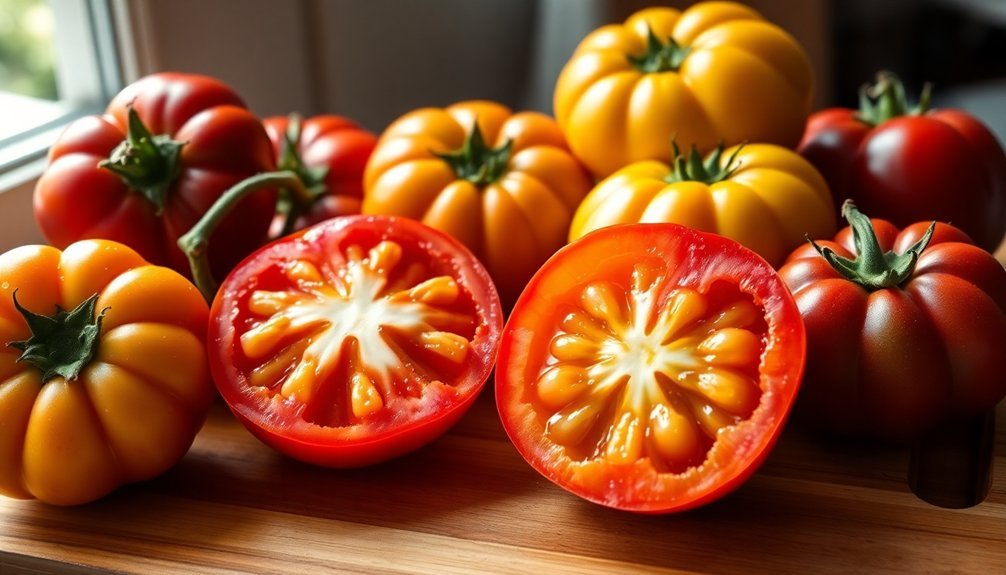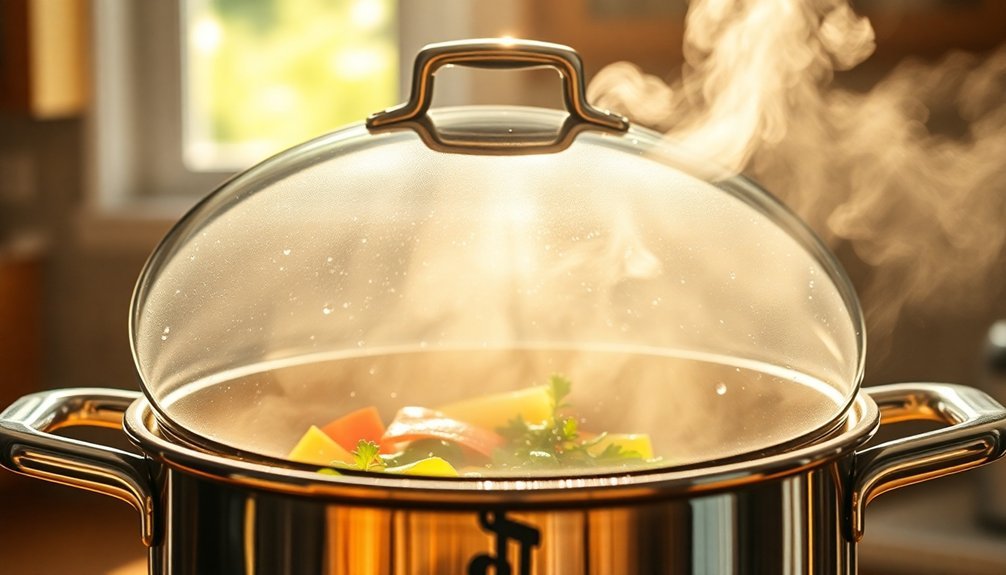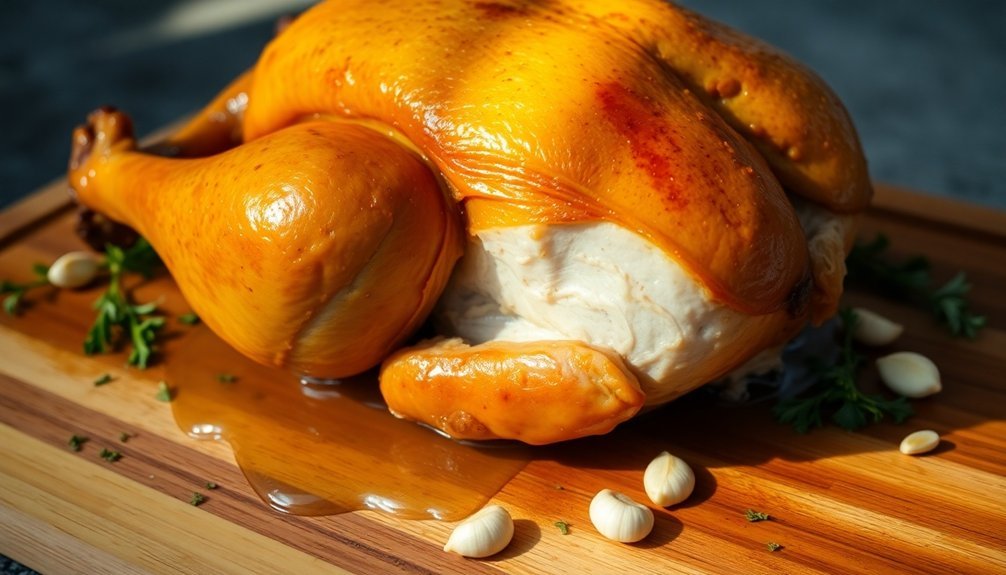To achieve juicy, sun-cooked meals, start with naturally moist ingredients like vegetables, fruits, and fatty meats that release their own flavorful liquids. You'll want to marinate your food for at least 30 minutes in a balanced mix of acidic and oily ingredients to enhance moisture retention. Use clear oven bags to create a steam-seal effect around your black cooking pots, positioning reflectors at 65° angles for best heat. Time your cooking carefully – quick methods work best for water-rich vegetables to maintain their crisp texture. When serving, preserve natural juices through proper temperature control and storage techniques. These fundamentals will reveal even more succulent solar cooking possibilities.
Selecting High-Moisture Base Ingredients

When selecting ingredients for solar cooking, understanding moisture content is essential for ideal results. You'll find that most vegetables, fruits, and meats naturally release water during cooking, which helps maintain tenderness and flavor.
Choose vegetables and fruits as your base ingredients since they're naturally high in moisture content. Meats, particularly those with higher fat content, will create their own juices while cooking.
You can combine these ingredients with grains or legumes, which will benefit from the natural moisture released during the cooking process. Remember that sealing jars or cans should be avoided to prevent dangerous pressure from building up.
Don't worry about adding extra liquid – the natural moisture from your ingredients is usually sufficient. While condensation might form on your solar cooker's lid, it won't greatly impact your cooking results.
You can quickly vent excess steam by briefly opening the lid if needed.
Marinade Magic for Solar Cooking
Creating the perfect marinade for solar cooking takes your dishes from good to exceptional. Your marinade should balance acidic ingredients like lemon juice with oil, aromatics, and sweet elements to tenderize and flavor your food.
When using a solar cooker, you'll want to guarantee even distribution and proper timing to maximize the sun's energy. The SunGood 360 oven provides consistent temperature control for optimal marinade absorption.
- Combine citrus juices or pineapple with olive oil, garlic, and herbs for a balanced base
- Cool your marinade before applying it to prevent premature cooking
- Allow at least 30 minutes of marination time, adjusting based on your solar cooker type
- Use a covered black pot or high-temperature baking bag to trap heat and enhance absorption
- Position your solar cooker at the ideal angle and rotate food periodically for even cooking
Steam-Lock Pot Setup

While marinating enhances flavor, proper steam-lock pot setup maximizes your solar cooker's efficiency. You'll need to position your reflectors at a 65° angle and guarantee they're tracking the sun's movement throughout the day. Using clear oven roasting bags will create an effective heat trap around your cooking vessel. The smaller 3-liter pot in the new HotPot kit provides improved solar cooking efficiency for temperate zones.
| Setup Element | Function | Key Tip |
|---|---|---|
| Reflectors | Direct sunlight | Adjust every 30 mins |
| Roasting Bags | Heat retention | Check for tears |
| Pot Position | Steam control | Center placement |
Don't exceed the 6.42-pound weight limit for your solar pot, as this guarantees ideal heat distribution. You'll achieve the best results by monitoring your cooker's temperature and making small adjustments to maintain consistent heat levels. Think of your setup as similar to a 250-watt Crock-Pot – it's slower but equally effective.
Water-Rich Timing Methods
Since water-rich foods cook differently than their drier counterparts, you'll need to adjust your timing methods accordingly. When preparing dishes with high water content ingredients like watermelon, cucumber, or zucchini, timing becomes essential to preserve both nutrients and texture.
- Start with quick-cooking methods for water-rich vegetables like watercress and lettuce to maintain their crispness.
- Add cucumber and celery last in cold dishes to prevent excess water release.
- Cook zucchini for just 3-4 minutes to avoid a mushy consistency.
- Time your broth-based soups to simmer, not boil, preserving the vegetables' structure.
- Serve watermelon-based dishes immediately after preparation to prevent water pooling.
Preserve Natural Juices While Serving

The art of preserving natural juices extends beyond preparation to the serving stage. You'll want to maintain temperature control throughout the entire process, keeping freshly squeezed juices refrigerated immediately to maximize their 2-3 day lifespan. Adding natural citrus can help preserve your juices longer due to their natural acidity.
For longer storage, you've got several effective options. You can use thermal pasteurization, heating juices to 95°C for 15 seconds, though this might affect taste.
If you're aiming to preserve nutritional value, consider non-thermal methods like high-pressure treatment or sterile filtration. For the best long-term results, freeze your juices, but remember to leave 2-inch headspace in containers for expansion.
Whether you're serving immediately or storing, maintain strict sanitation practices from preparation through serving to guarantee the best quality.
Frequently Asked Questions
Can Sun-Dried Foods Still Spoil if Exposed to Humidity After Storage?
Yes, your sun-dried foods can spoil when exposed to humidity after storage. You'll notice mold growth and spoilage if moisture levels rise above 60%, especially if they're not kept in airtight containers.
How Do Different Altitudes Affect Solar Cooking Times and Moisture Retention?
At higher altitudes, you'll notice faster cooking times due to increased solar radiation, but you'll need better moisture control. Your food can dry out quickly, so make certain your solar cooker has proper sealing and insulation.
Which Materials Should Be Avoided in Solar Cooking Pots?
You'll want to avoid shiny materials like stainless steel, copper, and aluminum foil, as they reflect sunlight. Don't use heavy cast iron, glass, or white cookware since they're inefficient at heat absorption and retention.
Does Cloud Cover Impact the Rehydration Process of Sun-Dried Ingredients?
Yes, cloud cover during drying affects how your ingredients rehydrate later. You'll notice slower or uneven rehydration in foods dried under cloudy conditions, which can impact their final texture and overall quality.
Can Leftover Marinade Be Safely Reused for Future Solar Cooking Sessions?
You shouldn't reuse leftover marinade that's touched raw food due to bacterial contamination risks. If you must reuse it, you'll need to boil it first at 212°F to kill harmful bacteria.
In Summary
You've now mastered the essentials of keeping your sun-cooked meals wonderfully juicy. By choosing moisture-rich ingredients, perfecting your marinade game, setting up proper steam seals, timing your cooking precisely, and handling the serving process with care, you'll create solar dishes that burst with natural flavors and juices. Don't hesitate to experiment with these techniques – your sun-cooking journey's about to get a whole lot juicier.





Leave a Reply